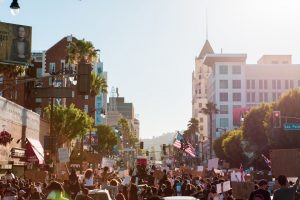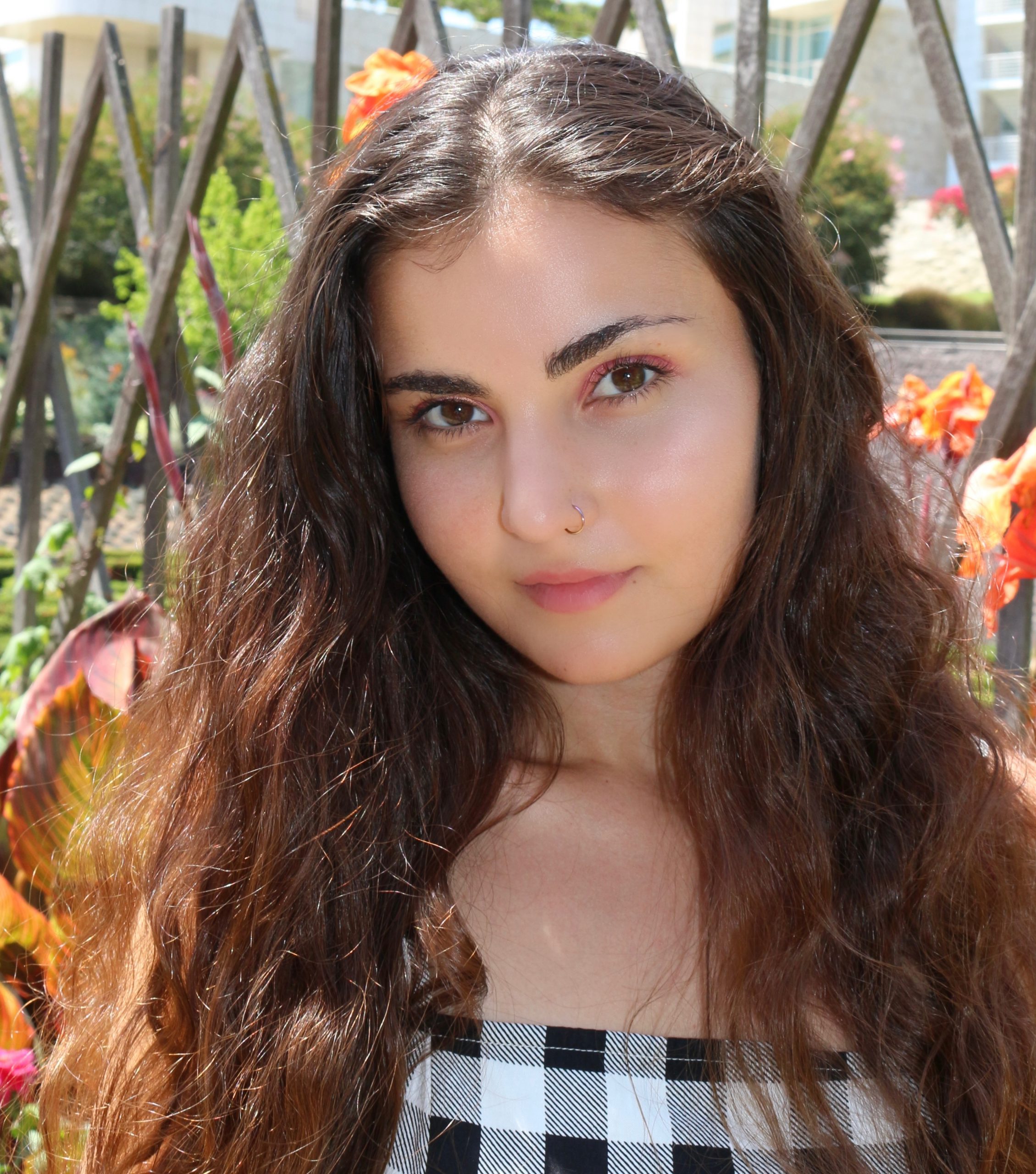All we need is a black and white filter slapped on this passed year, and one might mistake modern day for the 1960s. Except it’s not.
Chapman activists, protestors, and allies have learned a lot this year. They have explored their relationship with their own personal activism, and learned what causes they want to fight for.
Let’s go back to where activists literally hit the ground running with picket signs and passion.
Summer of 2020.
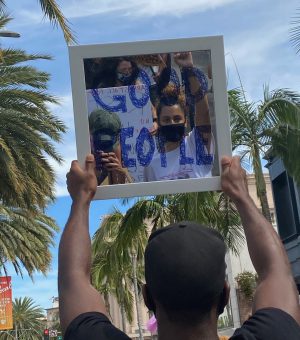
Haley Slovenec, a senior English major with an emphasis on journalism and a women’s studies minor, has used her voice as her biggest secret weapon this year.
“My first protest was last year, right around the time George Floyd was murdered,” said Slovenec. “There were so many protests in the following months. It became my full time job. I literally stopped working for a month, just to go to protests.”
Later that summer, Slovenec nervously accepted to give a speech at a Paddle Out rally. Whether she wanted to or not, Slovenec had been pinned as the activist of San Clemente.
She wrote her speech in all of one hour.
“One of the major breakthroughs I had with the audience was when I talked about what happened to me in high school,” said Slovenec. “There was this guy who liked me, and I didn’t like him back. One day, we were in class and everyone started quietly laughing. I was thinking, ‘what’s going on?’ My friend was like, ‘don’t look at it.’ ‘Just ignore it.’ It turns out this guy had drawn a picture of me being hung by the KKK. I didn’t even want to tell anyone what happened….which really goes to show how our society is. Nothing ended up happening to that kid. They just told him to not do it again.”
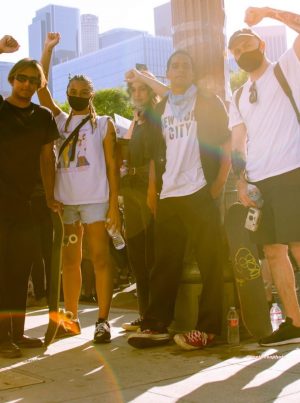
It’s easy to think of San Clemente as just a quaint beach town littered with surfer bros and malls. It’s an untrue ideology that we cling to, thinking that racial hatred can’t rear its ugly head in the places you’d least expect it.
The drive and commitment that Chapman’s POC activists have is powerful, but the point of contention still remains as large as the racism at hand.
To continuously speak on these issues falls on POC shoulders, while simultaneously falling onto deaf ears. The Chapman campus lacks a real presence of anti-racist, powerhouse activism.
The students are trying to change that.
Marisa Quezada, a junior sociology major and women and gender studies with a university honors program double minor, wanted to incorporate her own activism into her career. Quezada worked alongside a group coined the Capistrano Unified School District Against Racism, in which she reads countless testimonies, codes, writes and researches on their behalf.
“I’ve been shifting my thinking away from how I should do better for my ancestors, because so many sacrifices went in for me to be able to go to a private university like Chapman as a child of an immigrant,” said Quezada. “We live in this colorblind society, where people say things like ‘I don’t see color,’ or ‘I treat everyone as equals.’ Well, I don’t think everyone is equal. People have different needs.”
Quezada read pages of testimonies, one of them from a girl who wore a hijab. This student would change in the bathroom instead of a communal changing room. The pervading Western cultural norms are often the only acceptable norms in American schools.
The student felt that she should not be punished nor ridiculed for abiding by different religious needs. “A blanket statement of ‘everyone should be treated equal’ doesn’t make sense,” said Quezada.
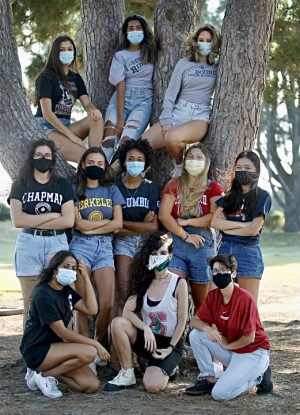
CUSD Against Racism received 850 testimonies about racism at Quezada’s old high school. Quezada was able to compile that evidence to the school and presented it as a problem that needed to be addressed.
But these dress code policy testimonies kept cropping up. These testimonies eventually inspired Quezada’s thesis project about how dress codes reinforce whiteness.
“Girls from the school would say that the dress code only applied to Black and Latina girls,” said Quezada.
One of the ideas Quezada has been referencing details how the American dress code reinforces a white, middle-class norm of what an academically successful student should look like. Professionalism culture is not an exception to white supremacist idealologies.
Arleth Ulloa, a sophomore political science and English journalism double major, serves as the Vice President of the Latinx club, and she has done what she can to help educate and enact small changes in the Latinx Club.
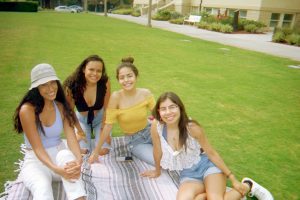
“When the white supremacists stickers were going around on campus, we were among the first organizations who spoke about it, and offered to hold space for others to speak,” said Ulloa.
The disbanding of the Black Student Union has affected them greatly.
“The President of the Latinx club and I had a long conversation when the entire BSU executive board resigned,” Ulloa said. “It was very sad for us because we worked alongside BSU for so many events. They’re a helpful, great resource. It’s sad to see their work go unnoticed. I can understand the frustration. Latinx is dealing with the same issue of Zoom fatigue and low turnout. There’s only so many Kahoots you can do.”
The Black Student Union board members, comprised entirely of Black women, recently posted their letter of resignation on The Panther.
“I can’t imagine the position BSU were in to come to that decision to resign,” said Ulloa.
BSU explained how they have received significant disrespect and indifference from Chapman University, as well as a lack of support from the Black community.
Professor Rozell Nesbitt, has only been teaching at Chapman University for three years, but has had an extensive career as a social worker, union organizer, and an activist who’s worked alongside Dr. Martin Luther King Jr. and Nelson Mandela, and weighed in on the activism efforts taking place on city streets, as well as on campus.
Something Dr. Nesbitt noticed about Chapman University was the iconic bust of Dr. Martin Luther King Jr.
Dr. King spoke at Memorial Hall in 1961.
“At marches and demonstrations we always made sure to keep the leaders protected,” said Dr. Nesbitt. “We were called marshalls. And you didn’t fight people. It was a non-violent demonstration, but you put your body in the way to avoid others getting hurt.”
In 1966, Dr. Nesbitt attended a march in Market Park, Chicago. Dr. Nesbitt was tasked with guarding Dr. Martin Luther King Jr. Suddenly, a brick flew through the air.
He failed to intercept the brick.
“It hit King in the head,” said Dr. Nesbitt. “And he went down. I felt terrible about it, but then he looked up at me and said, ‘Prexy, I thought you were a football player!’”
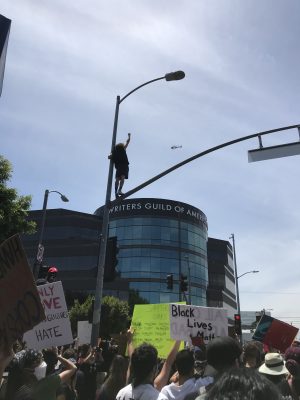
The biggest problem behind Chapman’s lack of support is that they have failed to root themselves in an anti-racist approach.
“I think the Diversity, Equity and Inclusion was finally created because Chapman came to the conclusion they had a deep problem,” said Dr. Nesbitt. “But I don’t think the DEI is addressing racism. It’s an institutional character, and there are many manifestations of it.”
One of these manifestations was how Dr. Nesbitt noticed the groundworks and maintenance staff were nearly all of Latino descent.
“I never see any white people doing that. It makes for an apartheid structure,” said Dr. Nesbitt.
In response to BSU feeling the pressure and lack of support to the point that they had to step down for the time being, Dr. Nesbitt feels there should be improved guidance and aid.
“One of the roles Don Will played was he was the main faculty advisor to the Black students. I don’t see such an advisor nowadays. A real faculty member, I think it would have been a great help,” said Dr. Nesbitt.
Kayla Wierchert has worked at Chapman since 2010, and has worked with Chapman’s recognized clubs since 2013.
“BSU obviously made the decision to go dormant right now because of the pressure that they were feeling,” said Wierchert. “That was their own decision, and their own reaction. I can tell you that we are strongly hoping for a time where members of BSU feel comfortable returning, because I think they’re very needed on campus.”
The Chapman Activists are another popular activist group who made the decision to not register their club under Chapman University.
“I haven’t spoken with this group about why they made the decision to not be a recognized group,” said Wierchert. “To my knowledge, I can’t think of restrictions about why they wouldn’t want to be a registered group. Unless it was Covid related restrictions, I just don’t know what they were worried about.”
Natalia Ventura, a senior peace studies major with a self-designed aesthetic activism minor, is a key member of the Chapman Activists. Ventura has extensively studied social movements, activism, and propaganda.
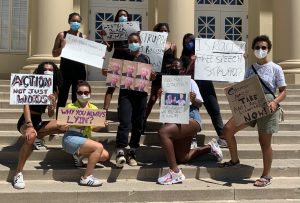
Ventura and her roommate, Lucille Henderson, have been involved on the activist forefront since their freshman year. It followed them home, and they felt they needed to make a campus wide coalition to bring Chapman activists together.
“No one ever sat down and saw our actions on campus as a collective movement,” said Ventura. “After doing this work for three years, we realized we can’t depend on our administration to make the changes we want to see. It needs to come from the student voices. And historically, all major changes at universities have come from student movements.”
The Chapman Activists elected to not register their group under the university. This is partly due to activism groups needing to have last minute gatherings, protests, and rallies. The logistical aspects would not have worked under the confines of a college club.
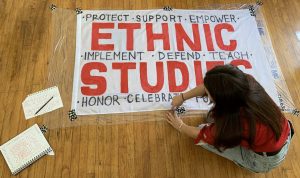
“To be a radical force for change, you can’t really do that under the purview of the institution and administration. Yes, there’s some language about diversity and inclusion, but it’s still largely passive and they still expect people to assimilate to a dominant white culture.”
Ventura stated that Chapman is not unique in terms of hate incidents. It is a national problem.
However, the way Chapman responds to racial hatred is somewhat unique.
According to Ventura, there is a pattern of students doing everything in their power to try and fix the passive atmosphere at Chapman, and then those students burn out from lack of support.
Ventura believes that Chapman’s lack of a more aggressive approach to racism is ingrained in the system, not any individual member of faculty.
However, this endless cycle is a detriment to POC students and a key reason why Black students are straying away from Chapman University in general.
“The leaders of (Chapman Activists) didn’t get support,” said Dr. Nesbitt. “They didn’t feel integrated or welcomed by the school. I think it has to do with very serious, structural, and institutional problems at Chapman. There is an incredible rate of African Americans leaving this school. They just don’t feel welcome.”
One of the first things Dr. Nesbitt was told when he arrived at Chapman was that the head of the communications department was running against Katie Porter on a ticket to bring back the John Birch Society, a radical far-right organization.
“I was shocked,” said Nesbitt.
It’s likely that the deep uncomfortability the university evokes onto POC students cannot be entirely blamed on one person.
“Even if Struppa resigned, there would be a new figurehead to replace him,” said Ventura. “ We need to tackle this at the root. It’s worse because we’re in a conservative area.”
Ventura stated that Chapman’s donors have politically conservative interests, and actively serve the white population of students more than students of color.
“Chapman is a great school only if you have a lot of privilege and aren’t affected by the issues that students of color are affected by,” said Ventura. “The school can do things to make sure that every student feels accommodated for…every student should have the same positive experience of a white, wealthy student.”
